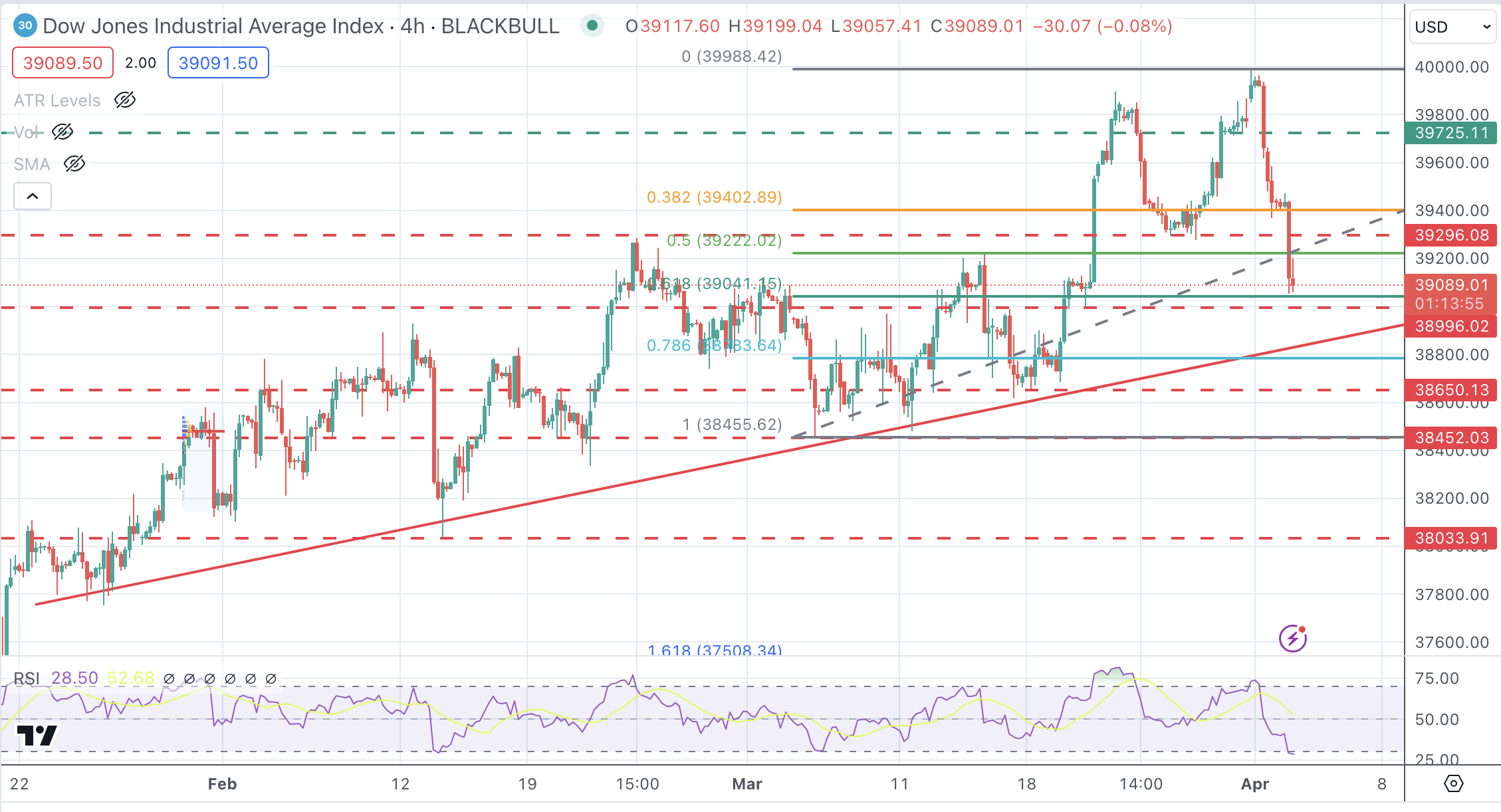- Analytics
- News and Tools
- Market News
- Dow Jones Industrial Average retreats further as Fed cut hopes fade
Dow Jones Industrial Average retreats further as Fed cut hopes fade
- Dow Jones extends its reversal as doubts about a June rate cut increase.
- US Factory Orders and JOLTS Job openings endorse the “no-landing” scenario for US the economy.
- The health sector is leading losses as Medicare rates have disappointed investors.
The main Wall Street indexes are going down for the second consecutive day on Tuesday. The Dow Jones Industrial Average (DJIA) is leading following strong US Factory Orders and JOLTS Jobs Opening data.
Orders for products manufactured in the US have increased 1.4% in February, following a 3.8% decline and beating expectations of a 1% increase. Beyond that, Job Openings have increased from 8.748 million to 8.756 million , above the 8.74 million expected by the markets.
The recent US data confirms the strong US economic outlook and a tight labor market, far from the ideal scenario to start lowering borrowing costs. This has left investors wondering about June’s rate cut, which sent US yields and the US Dollar higher while equities bled.
Dow Jones news
The Dow Jones Index declines 1.23% to 39,078 on Tuesday’s morning trade. The Health sector is leading losses with a 1.98% decline following reports that the Biden administration has failed to increase Medicare rates to the extent investors would have hoped.
The Consumer Discretionary sector drops 1.62%. Only the Energy and Utilities sectors are trading above opening levels with increases of 0.53% and 0.24%, respectively.
United Health Group (UNH) is the biggest loser on Tuesday with a 7.6% sell-off to $452.73. Next is Intel (INTC), trading 2.06% below opening levels to $43.60.
On the positive side, Dow Inc (DOW) advances 0.55% to $58.58 with Verizon Communications (VZ) up 0.4% to $42.45.
Dow Jones technical outlook
The technical picture shows the Dow Jones Index correcting lower with the broader bullish trend still intact. Price Action has broken the 50% Fibonacci retracement of the March rally, at 39,300, and is heading to the 39,000 support area. Further down, trendline support is at 38,835.
On the upside, the mentioned support at 39,300 might act as a resistance now and close the path toward the key area at 40,000.
DJIA 4-Hour Chart

Dow Jones FAQs
The Dow Jones Industrial Average, one of the oldest stock market indices in the world, is compiled of the 30 most traded stocks in the US. The index is price-weighted rather than weighted by capitalization. It is calculated by summing the prices of the constituent stocks and dividing them by a factor, currently 0.152. The index was founded by Charles Dow, who also founded the Wall Street Journal. In later years it has been criticized for not being broadly representative enough because it only tracks 30 conglomerates, unlike broader indices such as the S&P 500.
Many different factors drive the Dow Jones Industrial Average (DJIA). The aggregate performance of the component companies revealed in quarterly company earnings reports is the main one. US and global macroeconomic data also contributes as it impacts on investor sentiment. The level of interest rates, set by the Federal Reserve (Fed), also influences the DJIA as it affects the cost of credit, on which many corporations are heavily reliant. Therefore, inflation can be a major driver as well as other metrics which impact the Fed decisions.
Dow Theory is a method for identifying the primary trend of the stock market developed by Charles Dow. A key step is to compare the direction of the Dow Jones Industrial Average (DJIA) and the Dow Jones Transportation Average (DJTA) and only follow trends where both are moving in the same direction. Volume is a confirmatory criteria. The theory uses elements of peak and trough analysis. Dow’s theory posits three trend phases: accumulation, when smart money starts buying or selling; public participation, when the wider public joins in; and distribution, when the smart money exits.
There are a number of ways to trade the DJIA. One is to use ETFs which allow investors to trade the DJIA as a single security, rather than having to buy shares in all 30 constituent companies. A leading example is the SPDR Dow Jones Industrial Average ETF (DIA). DJIA futures contracts enable traders to speculate on the future value of the index and Options provide the right, but not the obligation, to buy or sell the index at a predetermined price in the future. Mutual funds enable investors to buy a share of a diversified portfolio of DJIA stocks thus providing exposure to the overall index.
© 2000-2024. All rights reserved.
This site is managed by Teletrade D.J. LLC 2351 LLC 2022 (Euro House, Richmond Hill Road, Kingstown, VC0100, St. Vincent and the Grenadines).
The information on this website is for informational purposes only and does not constitute any investment advice.
The company does not serve or provide services to customers who are residents of the US, Canada, Iran, The Democratic People's Republic of Korea, Yemen and FATF blacklisted countries.
Making transactions on financial markets with marginal financial instruments opens up wide possibilities and allows investors who are willing to take risks to earn high profits, carrying a potentially high risk of losses at the same time. Therefore you should responsibly approach the issue of choosing the appropriate investment strategy, taking the available resources into account, before starting trading.
Use of the information: full or partial use of materials from this website must always be referenced to TeleTrade as the source of information. Use of the materials on the Internet must be accompanied by a hyperlink to teletrade.org. Automatic import of materials and information from this website is prohibited.
Please contact our PR department if you have any questions or need assistance at pr@teletrade.global.















